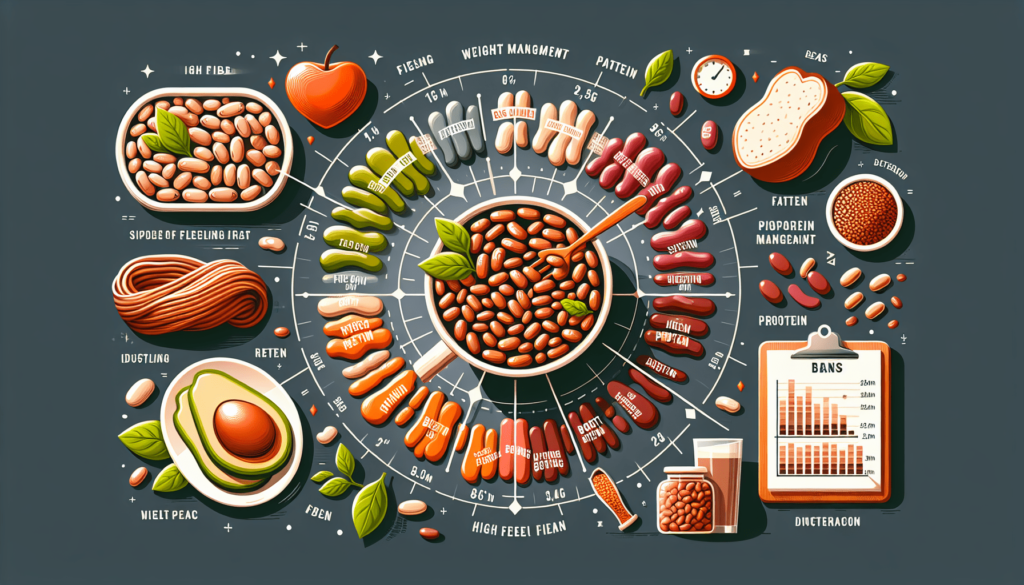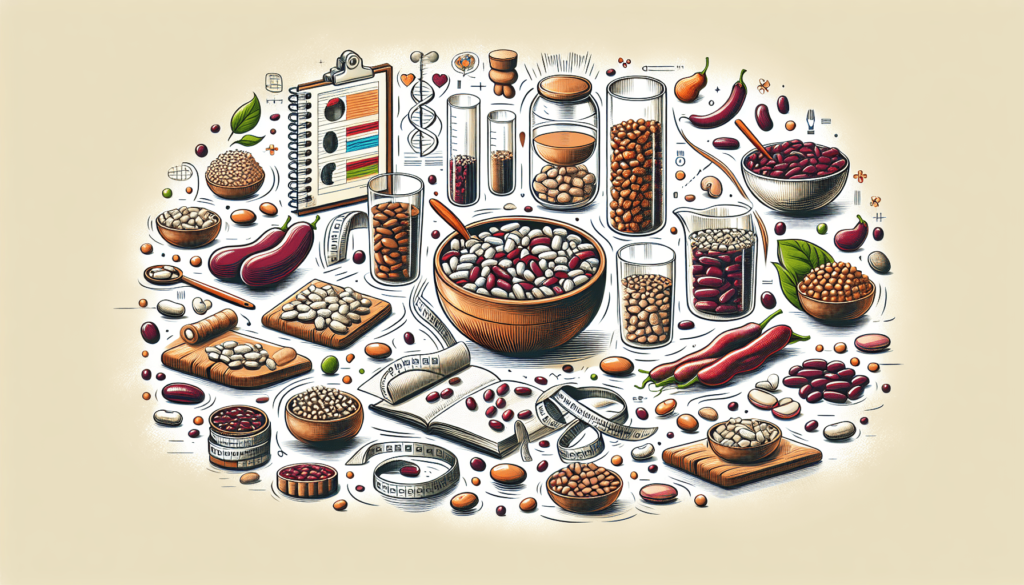In today’s fast-paced world where it feels like everyone is constantly on the go, maintaining a healthy weight and feeling satisfied with our meals can be a challenge. But fear not, because there’s a simple and delicious solution that can help: beans! Yes, those humble legumes that have been a staple in diets around the world for centuries have some remarkable benefits when it comes to weight management and satiety. How exactly do beans work their magic? Let’s explore the ways in which these nutritional powerhouses can support our goals and keep us feeling full and satisfied throughout the day.
Beans and Weight Management
Beans are a versatile and nutritious food that can play a significant role in weight management. Whether you are looking to lose weight or maintain a healthy weight, beans can be a valuable addition to your diet. They offer many benefits, including their nutrient composition, fiber content, low glycemic index, and protein content.
Nutrient Composition of Beans
Beans are packed with essential nutrients that are beneficial for overall health. They are an excellent source of vitamins, minerals, and antioxidants. They are particularly rich in folate, iron, potassium, and magnesium. These nutrients support various bodily functions and contribute to optimal health.
Fiber Content in Beans
One of the standout features of beans is their high fiber content. Fiber is an essential component of a healthy diet, especially when it comes to weight management. It helps regulate digestion, keeps you feeling fuller for longer, and aids in maintaining a healthy weight. By including beans in your meals, you can easily increase your fiber intake and promote satiety.
Low Glycemic Index of Beans
Another factor that makes beans beneficial for weight management is their low glycemic index. The glycemic index (GI) is a measure of how quickly a particular food raises blood sugar levels. Foods with a low GI are beneficial for weight management as they provide a gradual release of energy and help stabilize blood sugar levels. Beans have a low GI, making them an excellent choice for those looking to manage their weight effectively.
Protein Content in Beans
Protein is an essential macronutrient involved in numerous functions within the body, including muscle growth and repair. Beans are an excellent plant-based source of protein, making them ideal for individuals following vegetarian or vegan diets. Including beans in your diet can help increase protein intake and promote feelings of fullness, ultimately aiding in weight management.
Beans and Satiety
Satiety refers to the feeling of fullness and satisfaction after a meal. It is a crucial aspect of weight management as it helps control portion sizes and prevents overeating. Beans have several attributes that contribute to satiety, including their high fiber content, slow digestion rate, and protein content.
High Fiber Content in Beans
As mentioned earlier, beans are rich in fiber, which plays a significant role in promoting satiety. When consumed, fiber absorbs water and expands in the stomach, creating a feeling of fullness. This can help reduce overall calorie intake and prevent snacking between meals. Incorporating beans into your diet can enhance feelings of fullness and contribute to successful weight management.
Slow Digestion and Satiety
Beans are digested slowly, meaning they take longer to break down and move through the digestive system. This slow digestion rate contributes to prolonged feelings of fullness and can help control appetite. By incorporating beans into your meals, you can experience more extended periods of satiety, reducing the likelihood of overeating or reaching for unhealthy snacks.
Impact of Protein Content on Satiety
Protein is known to be highly satiating, meaning it promotes feelings of fullness. Beans, as a plant-based protein source, can be an excellent addition to your diet for promoting satiety and managing weight. Including beans in your meals can help balance macronutrient intake, reduce cravings, and contribute to a satisfying eating experience.

Types of Beans for Weight Management and Satiety
There is a wide variety of beans available, each with its unique nutritional profile and flavor. When it comes to weight management and promoting satiety, certain types of beans stand out for their specific attributes.
Black Beans
Black beans are a nutritious choice when aiming for weight management and satiety. They are rich in fiber and protein, making them highly filling. Additionally, black beans have a robust and earthy flavor, perfect for adding depth to recipes such as salads, soups, or wraps.
Lentils
Lentils are a versatile legume that is packed with nutrients. They are high in fiber and protein but low in calories, making them an excellent choice for weight management. Lentils also have a low glycemic index, ensuring a gradual release of energy that supports satiety. With their mild taste and quick cooking time, lentils can be easily incorporated into various dishes such as stews, curries, and salads.
Chickpeas
Chickpeas, also known as garbanzo beans, are a popular choice for weight management due to their high fiber and protein content. They have a nutty and creamy flavor, ideal for making hummus, soups, or roasted snacks. Incorporating chickpeas into your diet can help promote satiety and provide essential nutrients.
Kidney Beans
Kidney beans are not only visually appealing with their vibrant red color, but they are also a nutritious choice for weight management. They are rich in fiber, protein, and antioxidants, making them a healthy addition to your meals. Kidney beans work well in a range of recipes, including chili, salads, or bean-based burgers.
Navy Beans
Navy beans, also known as white beans, are a versatile legume that can be used interchangeably with other types of beans. They are low in fat, high in fiber, and packed with nutrients. Navy beans have a mild flavor, which makes them an ideal choice for a variety of dishes, such as soups, stews, or casseroles.
Cooking Beans for Optimal Benefits
To fully enjoy the benefits of beans for weight management and satiety, it is essential to prepare them properly. Here are some tips for cooking beans to optimize their nutritional content and flavor.
Soaking Beans
Before cooking beans, it is recommended to soak them overnight. Soaking beans helps to remove some of the indigestible sugars that can cause gas and digestive discomfort. Additionally, soaking can reduce cooking time and promote even cooking. After soaking, be sure to rinse the beans thoroughly before cooking.
Cooking Methods
There are several methods of cooking beans, each with its advantages. The most common methods include stovetop cooking, pressure cooking, and using a slow cooker. Stovetop cooking is the traditional method and requires simmering the beans in water until they are tender. Pressure cooking can significantly reduce cooking time, while slow cookers allow for hands-off preparation. Choose the method that suits your preference and time constraints.
Seasoning and Flavoring Beans
Beans have a mild taste, making them a blank canvas for various spices, herbs, and seasonings. Experiment with different flavor combinations to enhance the taste of your beans. Garlic, onion, cumin, chili powder, and herbs like thyme or rosemary are popular choices. Additionally, you can add vegetables, tomatoes, or broth to create more complex flavors in your bean-based dishes.

Including Beans in Your Diet for Weight Management and Satiety
Now that you understand the benefits of beans for weight management and satiety, it’s time to incorporate them into your diet. Here are some practical ways to enjoy beans and maximize their potential for promoting weight loss and satiety.
Replacing High-Calorie Ingredients with Beans
One simple way to incorporate beans into your diet is by replacing high-calorie ingredients with beans in your favorite recipes. For example, instead of using ground meat in tacos or chili, try using black beans or lentils. This swap can significantly reduce the calorie content while increasing the fiber and protein content of the meal.
Bean-based Meals and Snacks
There are countless bean-based meals and snacks that you can enjoy to support weight management and satiety. Consider making bean soups, salads, or wraps for lunch. Roasted chickpeas are a delicious and crunchy snack option. Let your creativity guide you when it comes to bean-based meals and snacks, and don’t be afraid to try new recipes.
Combining Beans with Other Foods
To create balanced and satisfying meals, combine beans with other nutritious foods. Pair beans with whole grains like quinoa or brown rice for a complete source of protein. Add vegetables, such as bell peppers, spinach, or tomatoes, for added nutrients and flavor. By combining beans with other foods, you can create well-rounded meals that support weight management and satiety.
Research and Studies on Beans and Weight Management
The benefits of beans for weight management and satiety have been the subject of various research studies. Here are some key findings from research examining the effects of bean consumption on weight loss and long-term weight management.
Effectiveness of Beans in Weight Loss Programs
Studies have shown that incorporating beans into weight loss programs can be effective in promoting weight loss and managing body weight. The high fiber and protein content of beans contribute to increased satiety and reduced calorie intake. Including beans in a calorie-controlled diet can enhance weight loss results and improve overall diet quality.
Comparison with Other Weight Loss Diets
When compared to other weight loss diets, beans have shown favorable results. Research has indicated that bean-based diets can lead to greater weight loss and improved health markers compared to diets that are higher in animal-based protein or processed foods. The nutrient density and satiating properties of beans make them an excellent choice for individuals looking to manage their weight effectively.
Long-Term Effects of Bean Consumption
In addition to short-term weight loss, studies suggest that long-term consumption of beans can have lasting effects on weight management. Regular bean consumption has been associated with lower body weight, reduced waist circumference, and a decreased risk of obesity. Incorporating beans into your diet on a consistent basis can contribute to sustainable weight management in the long run.
Practical Tips and Considerations
When incorporating beans into your diet for weight management and satiety, it is essential to keep a few practical tips and considerations in mind.
Gradually Increase Bean Consumption
If you are new to consuming beans, it is advisable to gradually increase your intake. This will allow your body to adjust to the increased fiber content and reduce the likelihood of digestive discomfort. Start by incorporating small portions of beans into your meals and gradually increase the portion sizes as your body becomes accustomed to them.
Monitoring Portion Sizes
While beans are nutritious and can support weight management, portion control is still important. Remember that beans, like any other food, contain calories. Be mindful of portion sizes to prevent overeating and ensure that your overall daily calorie intake aligns with your weight management goals.
Balanced Diet and Exercise
While beans can be a valuable tool in weight management, it is crucial to remember that no single food can guarantee weight loss on its own. It is essential to maintain a balanced diet that includes a variety of nutrient-dense foods alongside regular physical activity. Combine beans with other healthy foods and engage in regular exercise to achieve optimal weight management.
Bean Recipes for Weight Management and Satiety
To help you get started on incorporating beans into your diet, here are some delicious and nutritious bean recipes that support weight management and satiety.
Bean Soup with Vegetables
Ingredients:
- 1 cup of mixed beans (such as black beans, kidney beans, and navy beans)
- 1 onion, diced
- 2 carrots, diced
- 2 celery stalks, diced
- 3 garlic cloves, minced
- 4 cups of vegetable broth
- 1 bay leaf
- 1 teaspoon of dried thyme
- Salt and pepper to taste
Instructions:
- Soak the mixed beans overnight, then rinse them thoroughly.
- In a large pot, sauté the onion, carrots, celery, and garlic until softened.
- Add the soaked beans, vegetable broth, bay leaf, dried thyme, salt, and pepper to the pot.
- Bring the mixture to a boil, then reduce the heat and let it simmer for about 1-2 hours until the beans are tender.
- Remove the bay leaf, adjust the seasoning if necessary, and serve the bean soup hot.
Quinoa and Black Bean Salad
Ingredients:
- 1 cup of cooked quinoa
- 1 can of black beans, rinsed and drained
- 1 bell pepper, diced
- 1 cucumber, diced
- 1 tomato, diced
- 1/4 cup of chopped fresh cilantro
- Juice of 1 lime
- 2 tablespoons of olive oil
- Salt and pepper to taste
Instructions:
- In a large bowl, combine the cooked quinoa, black beans, bell pepper, cucumber, tomato, and cilantro.
- In a small bowl, whisk together the lime juice, olive oil, salt, and pepper to make the dressing.
- Pour the dressing over the quinoa and black bean mixture and toss to combine.
- Adjust the seasoning if necessary and refrigerate the salad for at least 30 minutes to allow the flavors to meld.
- Serve the quinoa and black bean salad as a refreshing and nutritious meal or side dish.
Roasted Chickpeas
Ingredients:
- 1 can of chickpeas, rinsed and drained
- 2 tablespoons of olive oil
- 1 teaspoon of paprika
- 1/2 teaspoon of garlic powder
- 1/2 teaspoon of cumin
- Salt and pepper to taste
Instructions:
- Preheat the oven to 400°F (200°C).
- Pat the chickpeas dry with a paper towel to remove any excess moisture.
- In a bowl, combine the chickpeas, olive oil, paprika, garlic powder, cumin, salt, and pepper. Toss until the chickpeas are evenly coated.
- Spread the chickpeas in a single layer on a baking sheet.
- Roast in the preheated oven for 25-30 minutes, stirring once or twice, until the chickpeas are crispy and golden brown.
- Remove from the oven and let the roasted chickpeas cool slightly before serving as a delicious and satisfying snack.
Bean and Veggie Wrap
Ingredients:
- 1 whole wheat tortilla
- 1/2 cup of cooked kidney beans
- 1/4 cup of diced bell peppers
- 1/4 cup of diced tomatoes
- 1/4 cup of diced cucumber
- 2 tablespoons of hummus
- Fresh spinach leaves
Instructions:
- Lay the whole wheat tortilla on a flat surface.
- Spread the hummus evenly over the tortilla.
- Layer the fresh spinach leaves, cooked kidney beans, diced bell peppers, tomatoes, and cucumbers onto the tortilla.
- Gently roll the tortilla, tucking in the sides as you go, until you have a tight wrap.
- Slice the wrap in half and secure the ends with toothpicks if needed.
- Enjoy the bean and veggie wrap as a satisfying and nutritious meal on the go.
Mixed Bean Chili
Ingredients:
- 1 tablespoon of olive oil
- 1 onion, diced
- 2 garlic cloves, minced
- 1 bell pepper, diced
- 1 can of diced tomatoes
- 1 can of mixed beans (such as black beans, kidney beans, and pinto beans), rinsed and drained
- 1 cup of vegetable broth
- 1 tablespoon of chili powder
- 1 teaspoon of cumin
- Salt and pepper to taste
- Optional toppings: shredded cheese, diced avocado, chopped cilantro
Instructions:
- In a large pot, heat the olive oil over medium heat.
- Add the diced onion, minced garlic, and diced bell pepper to the pot. Sauté until softened.
- Stir in the diced tomatoes, mixed beans, vegetable broth, chili powder, cumin, salt, and pepper.
- Bring the mixture to a boil, then reduce the heat and let it simmer for about 30 minutes to allow the flavors to meld.
- Adjust the seasoning if necessary and serve the mixed bean chili hot, topped with optional toppings if desired.
Potential Side Effects and Allergies
While beans offer numerous health benefits, some individuals may experience certain side effects or have allergies to specific types of beans.
Gas and Digestive Discomfort
Beans contain complex carbohydrates called oligosaccharides that can be difficult for some people to digest. This can lead to the production of gas and digestive discomfort, such as bloating or flatulence. To minimize these side effects, soaking the beans overnight and thoroughly rinsing them before cooking can help reduce the presence of these complex carbohydrates.
Individual Allergies to Certain Beans
It’s important to note that some individuals may have allergies or sensitivities to specific types of beans. Allergic reactions to beans are rare but can occur in susceptible individuals. If you experience any adverse symptoms after consuming beans, such as swelling, itching, or difficulty breathing, it is advisable to consult a medical professional.
Check this another article Read More
Conclusion
Incorporating beans into your diet can be a valuable tool for weight management and satiety. The nutrient composition, fiber content, low glycemic index, and protein content of beans make them an excellent choice for those looking to achieve and maintain a healthy weight. By choosing from a variety of beans and preparing them in delicious and nutritious ways, you can enjoy the benefits of beans while supporting your weight management goals. So why not add some beans to your next meal and experience the satiety benefits they have to offer.
